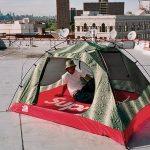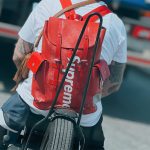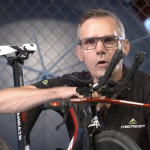VF Corporation posted a 3 percent decline in revenues in the fiscal third quarter ended December 31, with currency fluctuations impacting results by six percentage points to the negative. Constant-dollar sales were up 3 percent for the period versus the prior-year comp period. The “big four brands” were down 3 percent, or up 2 percent in constant dollars, and the balance of the portfolio was down 2 percent, or up 5 percent in constant dollars.
Earnings per share were down 1 percent to $1.31 for the quarter and adjusted EPS was down 17 percent to $1.12 per share. The parent company of The North Face, Vans, Timberland and Dickies, among other brands, also cut its shareholder dividend to 30 cents a share, reflecting a 41 percent decrease versus the previous quarter’s dividend.
VF said in a release that the company was reaffirming its “recently communicated full year 2023 EPS outlook” with revenue growth at approximately 3 percent, after navigating an increasingly challenging fiscal third quarter.
“First, we overcame a very challenging environment in Q3, where our performance highlighted examples of success, while also clearly showcasing areas to improve,” Interim President and CEO Benno Dorer stated on a Tuesday conference call with analysts. “Amidst the difficult geopolitical and economic backdrop, we grew Q3 revenue 3 percent in constant dollars. And today, we are reaffirming our revenue outlook at the low end of our prior range and also the midpoint of our EPS outlook for fiscal year 2023.” Dorer, formerly the company’s lead independent director, replaced former Chairman and CEO Steve Rendle in early December.
“The momentum we continue to generate with The North Face further proves this point,” Dorer continued. “The brand continues to perform strongly, driven by strong consumer engagement and iconic products. And we will keep investing to fuel that momentum.”
The North Face revenue was $1.3 billion in the quarter, up 7 percent for the period, or up 13 percent in constant dollars versus the prior-year period.
“Our Explorer Pass membership continued to grow significantly in Q3, up 2.1 million members to approximately 17 million in total,” Dorer shared. “It’s more than a jackets marketing campaign, launched the season and drove strong outerwear growth globally with the Nuptse jackets, and the recently relaunched Summit Series premium product line leading the business.”
“The brand’s momentum is strong and broad-based,” Dorer stated. “The North Face is a solid and transferable execution blueprint for Vans, and frankly, the entire VF portfolio in the Americas, where we must grow with consumers more consistently.”
Vans revenue fell 13 percent (down 9 percent in constant dollars) to $927 million, reflecting positive performances in Europe and Asia outside of Greater China, while the Americas remained negative. For more detail on the focus, and planned investment in the Vans brand, go here.
Timberland sales were said to be roughly flat at $596 million but were up 6 percent in constant dollars.
Dickies sales were down 16 percent (-13 percent in constant dollars) to $177 million in the quarter.
The Americas region saw revenues down 2 percent, or 1 percent in constant dollars, to $2.09 billion. EMEA region reported sales were down 2 percent $983 million, but grew 10 percent in constant dollars, the seventh consecutive quarter of double-digit growth in constant dollars. Asia Pacific region sales were down 7 percent to $453 million in Q3, but up 4 percent in constant dollars, reflecting a sequential improvement across the region. In Greater China, reported sales were down 11 percent but only down 1 percent in constant dollars. VF reported continued strong growth in the rest of Asia.
Consolidated gross margin was 54.9 percent of net sales in fiscal Q3, down 120 basis points versus the prior-year period. Adjusted gross margin 54.9 percent of sales, down 140 basis points due primarily to increased promotions.
Operating margin was 14.6 percent in Q3, down 410 basis points. Adjusted operating margin was 14.9 percent, down 280 basis points.
Inventories declined by $158 million at the end of the third quarter compared to fiscal second quarter-end but increased by 101 percent relative to last year. Excluding the increase of in-transit inventory of approximately $415 million, the increase was approximately 75 percent relative to last year, primarily driven by core and excess replenishment inventory. VF modified terms with the majority of its suppliers in the first quarter of fiscal 2023 to take ownership of inventory near the point of shipment rather than the destination.
“The second near-term priority at VF is to return to the company’s hallmark standard of excellence in the supply chain arena,” Dorer shared. “We are working through a variety of external and internal issues that impacted revenues and profits in a high-volume quarter like Q3. Lengthened manufacturing and freight lead times, larger upfront product buys, unpredicted demand spikes from elevated promotional activity in the quarter, plus higher than normal customer order cancellations add up to unsatisfactory customer service, elevated inventory and significantly higher costs. So we’re taking aggressive actions to address these issues.
Dorer said VF expects to be able to work excess seasonal inventory down to more normalized levels by the end of the fiscal fourth quarter.
“We will also leverage our logistics partnerships to reduce costs by improving ocean and parcel rates for the next fiscal year,” he explained. “And we will see a return to more normalized and predictable promotional patterns and anticipate moderating inflation, which we expect will contribute to lower costs through fiscal year 2024. We are committed to serving our customers better and to getting back to strong supply chain performance at improved costs. Again, much of this is within our control.”
The company said supply chain challenges remained persistent in the quarter and are being addressed, with actions in place to “return to full customer service at a normalized cost.” Still, inventories more than doubled versus Q3 last year, or up 75 percent when accounting for a shift in when the company takes ownership of the goods.
Looking ahead, the company reiterated its recent full fiscal year 2023 guidance calling for total VFC revenue to grow approximately 3 percent in constant dollars, within the previous outlook range.
- Vans revenue is expected to post a high-single-digit decline in constant dollars for the fiscal year, compared to the previous outlook for a mid-single-digit decline.
- The North Face is expected to be up by at least 14 percent in constant dollars, compared to the previous outlook of up at least 12 percent.
- Adjusted gross margins are now expected to be down approximately 200 basis points, compared to the previous outlook of down 100 to 150 basis points.
- Adjusted operating margin approximately is forecast at 9.5 percent, compared to the previous outlook of approximately 11.0 percent.
- Adjusted EPS is forecast at $2.05 to $2.15 per share, within the previous outlook of $2.00 to $2.20.
- Adjusted cash flow from operations is now seen at approximately $0.7 billion, compared to the previous outlook of at least $0.9 billion.
- Capital expenditures are now estimated at approximately $200 million versus the previous outlook of $230 million.
- Inventory is expected to reduce by approximately $300 million during the fiscal year fourth quarter.
For 2024, VF is forecasting the following:
- Total VF revenue up by at least low-single-digit percent in constant dollars
- Gross margin and operating margin expansion
- Operating earnings to grow by double-digits
- Operating cash flow to grow faster than earnings
The company’s capital deployment priorities in the near- to medium-term are focused on optimizing and driving the performance of the portfolio, reducing leverage and returning capital to shareholders.
VF is also evaluating and deploying a series of strategic actions to strengthen the company’s financial position and sharpen focus on its greatest value creation opportunities, including:
- Rightsizing the dividend payout to accelerate the return to the company’s target leverage ratio and provide additional financial flexibility, positioning VF to navigate the current macroeconomic challenges while continuing to make investments to advance its strategy. As a result, VF’s next quarterly per share payment will reduce to 30 cents from 51 cents per share. The company expects to grow future dividends in line with earnings.
- Continuing to pursue the portfolio optimization agenda. The company is commencing a review of strategic alternatives for its Global Packs business, consisting of the Kipling, Eastpak, and JanSport brands. While these iconic and profitable businesses are strong contributors of value, VF is committed to ensuring they are optimally positioned to achieve their full potential while enhancing management focus on the Company’s greatest strategic priorities.
- Concluding a number of asset sales during the second half of fiscal 2023, including the sale and leaseback of VF’s European headquarters in Stabio, Switzerland.
- Reducing working capital and aligning inventories to optimal levels, without compromising brand equity
- Increasing efforts to reduce costs in order to point resources toward the Company’s highest value creation. opportunities, including completing the previously announced actions which will deliver approximately $225 million in annualized savings once complete in FY24.
Matt Puckett, CFO, said: “As we close FY23 and move into FY24, we have clear plans in place to address the ongoing challenging macro-economic environment in the near term. I am confident the actions we are taking will lead to improved operating performance and will strengthen the Company’s financial position, enabling VF to deliver long-term, sustainable and profitable growth.”
Photo courtesy The North Face
















